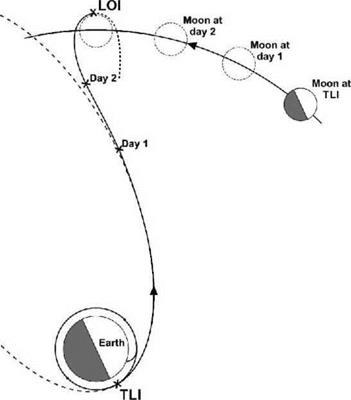Imagining the path
To help visualise the flight path to the Moon, imagine a vantage point looking dowm at Earth and the Moon from the north, with an Apollo spacecraft about to make a TLI burn for a free-return path. The spacecraft’s orbit around Harth is towards the east (anticlockwise in our visualisation), a direction it shares with the rotation of Harth. and indeed almost everything else in the solar system. The TLI burn is Limed to occur at a point in this orbit that is essentially on the opposite side of Earth from where the Moon and spacecraft will come together in three days. The burn places the spacecraft on a path that ordinarily would be a long, slow elliptical orbit with an apogee half a million kilometres out from Earth, somewhat beyond lunar distance. Meanwhile, at TLI the Moon is about 40 degrees further back in its path around Earth, moving at one kilometre per second towards the point where its orbit intersects the spacecraft’s path. The timing of TLI is such that the spacecraft reaches lunar distance shortly before the Moon comes along.
As it heads out, the influence of Earth’s gravity on the spacecraft gradually weakens while that of the Moon, approaching from the side, grows stronger; it attracts the spacecraft and deflects it from its original anticlockwise elliptic path. By virtue of careful calculation of the required trajectory, the spacecraft is aimed to pass near the Moon’s leading hemisphere and be pulled around its far side travelling in a clockwise direction. If nothing else is done, and if the timing and direction are correct, such a trajectory will, under the Moon’s gravitational influence, swing right around the lunar far side and fall back to Earth. Such a path would make its closest approach about midway around the far side and in order to stay in the Moon’s vicinity, the crew; must fire their main engine against their direction of travel at this
|
Apollo’s initial ellipse becomes a flight path to the Moon. |
point. This bum will take energy out of the spacecraft’s trajectory, slow it down and make it enter a clockwise, or retrograde lunar orbit.











